FY001: Management Structure, Business Functions, and Culture
VerifiedAdded on 2023/06/11
|9
|2021
|304
Report
AI Summary
This report provides an overview of management structures and business functions, highlighting their interrelation within an organization. It delves into Henry Fayol's five functions of management: planning, organizing, commanding, coordinating, and controlling, emphasizing their importance in achieving organizational goals. The report further analyzes the marketing function and its interplay with other departments like HR, emphasizing the significance of collaboration for overall growth and profitability. It also discusses HR and talent management, outlining the responsibilities of HR in managing employees and the key areas of talent management. Finally, the report explores organizational culture, its various types, and its impact on employee motivation and performance, concluding that a strong organizational culture is crucial for creating a positive and effective workplace environment. Desklib offers a wealth of similar solved assignments and study resources for students.

Introduction to
Management FY001
Management FY001
Paraphrase This Document
Need a fresh take? Get an instant paraphrase of this document with our AI Paraphraser
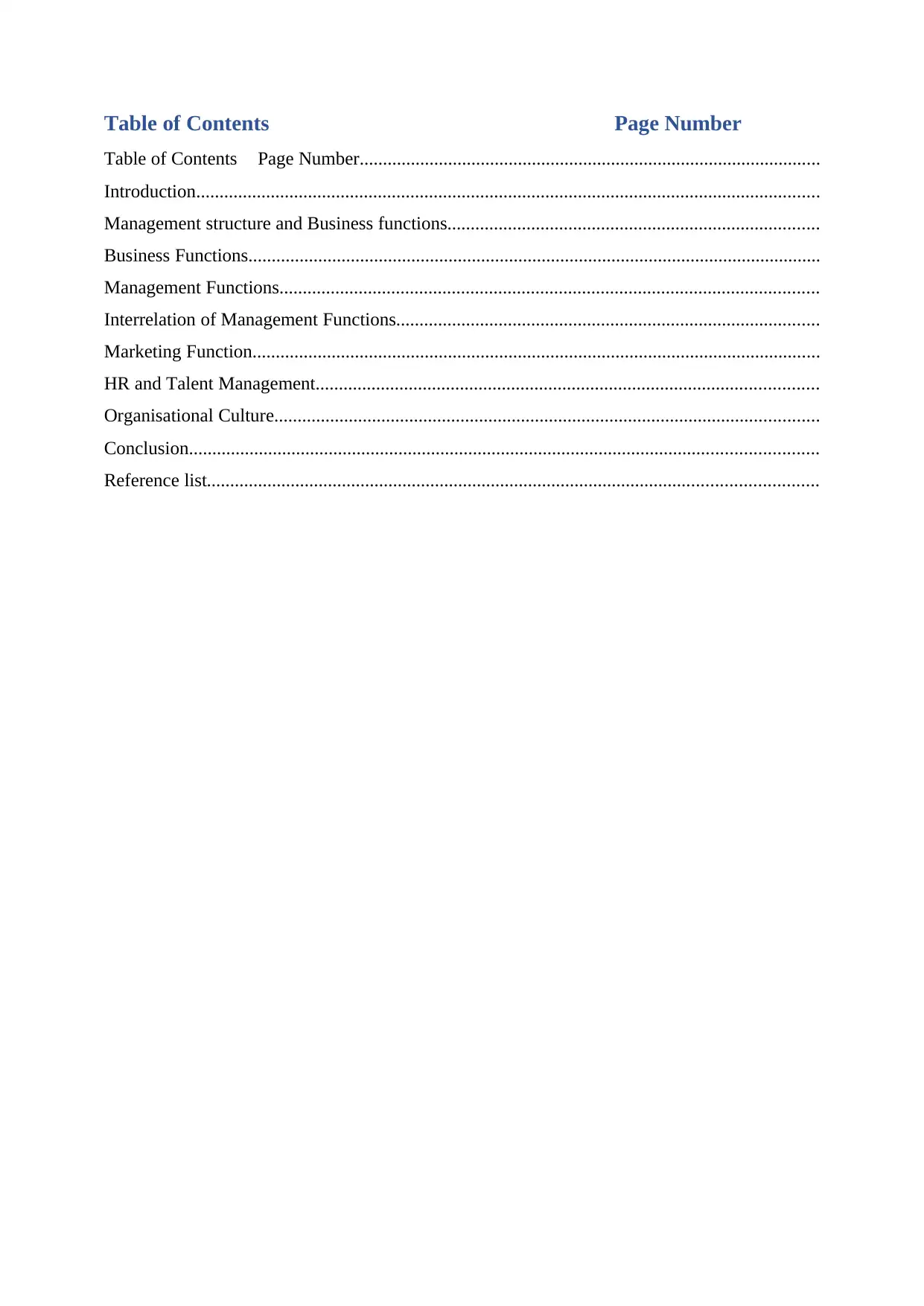
Table of Contents Page Number
Table of Contents Page Number...................................................................................................
Introduction......................................................................................................................................
Management structure and Business functions................................................................................
Business Functions...........................................................................................................................
Management Functions....................................................................................................................
Interrelation of Management Functions...........................................................................................
Marketing Function..........................................................................................................................
HR and Talent Management............................................................................................................
Organisational Culture.....................................................................................................................
Conclusion.......................................................................................................................................
Reference list...................................................................................................................................
Table of Contents Page Number...................................................................................................
Introduction......................................................................................................................................
Management structure and Business functions................................................................................
Business Functions...........................................................................................................................
Management Functions....................................................................................................................
Interrelation of Management Functions...........................................................................................
Marketing Function..........................................................................................................................
HR and Talent Management............................................................................................................
Organisational Culture.....................................................................................................................
Conclusion.......................................................................................................................................
Reference list...................................................................................................................................
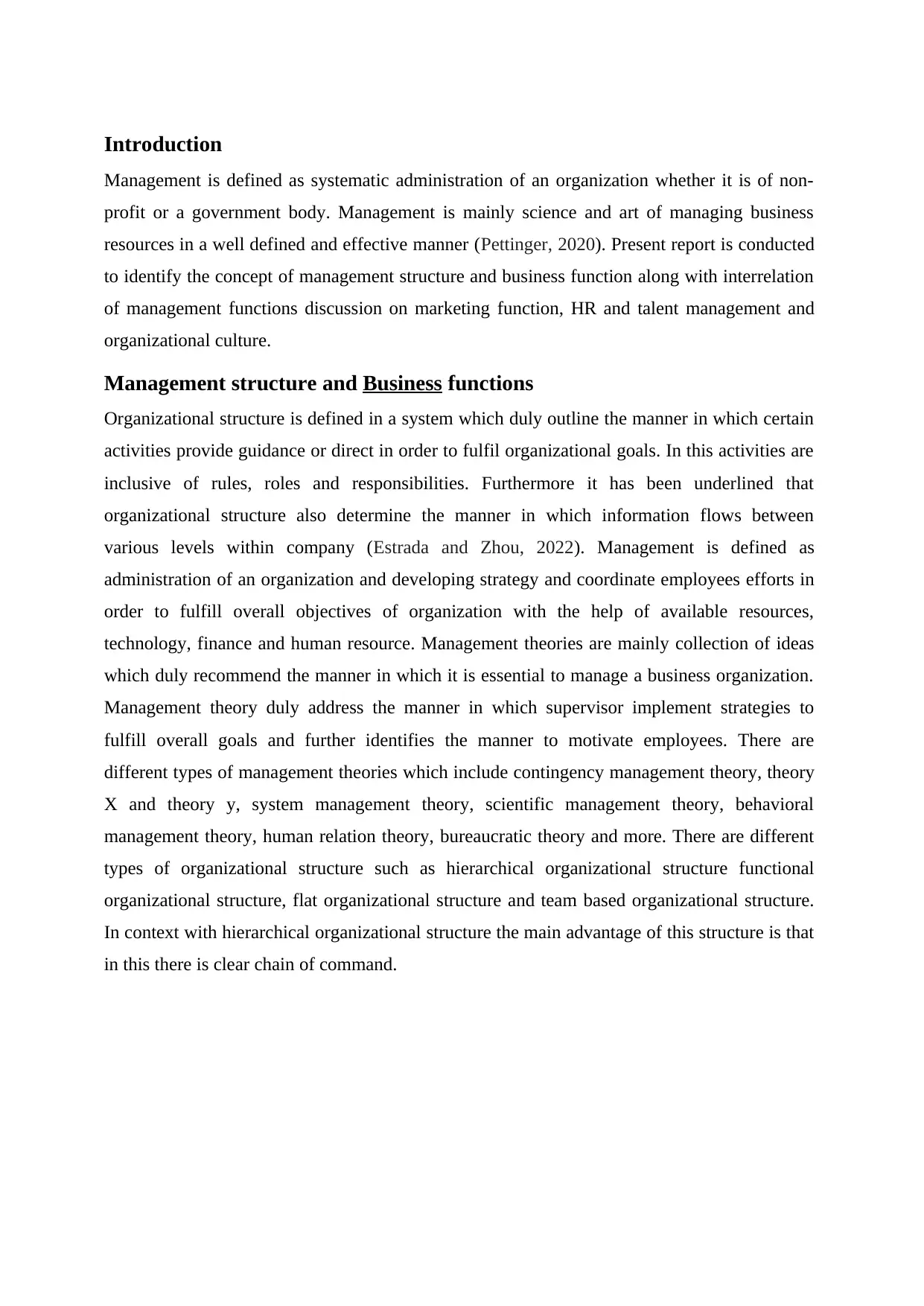
Introduction
Management is defined as systematic administration of an organization whether it is of non-
profit or a government body. Management is mainly science and art of managing business
resources in a well defined and effective manner (Pettinger, 2020). Present report is conducted
to identify the concept of management structure and business function along with interrelation
of management functions discussion on marketing function, HR and talent management and
organizational culture.
Management structure and Business functions
Organizational structure is defined in a system which duly outline the manner in which certain
activities provide guidance or direct in order to fulfil organizational goals. In this activities are
inclusive of rules, roles and responsibilities. Furthermore it has been underlined that
organizational structure also determine the manner in which information flows between
various levels within company (Estrada and Zhou, 2022). Management is defined as
administration of an organization and developing strategy and coordinate employees efforts in
order to fulfill overall objectives of organization with the help of available resources,
technology, finance and human resource. Management theories are mainly collection of ideas
which duly recommend the manner in which it is essential to manage a business organization.
Management theory duly address the manner in which supervisor implement strategies to
fulfill overall goals and further identifies the manner to motivate employees. There are
different types of management theories which include contingency management theory, theory
X and theory y, system management theory, scientific management theory, behavioral
management theory, human relation theory, bureaucratic theory and more. There are different
types of organizational structure such as hierarchical organizational structure functional
organizational structure, flat organizational structure and team based organizational structure.
In context with hierarchical organizational structure the main advantage of this structure is that
in this there is clear chain of command.
Management is defined as systematic administration of an organization whether it is of non-
profit or a government body. Management is mainly science and art of managing business
resources in a well defined and effective manner (Pettinger, 2020). Present report is conducted
to identify the concept of management structure and business function along with interrelation
of management functions discussion on marketing function, HR and talent management and
organizational culture.
Management structure and Business functions
Organizational structure is defined in a system which duly outline the manner in which certain
activities provide guidance or direct in order to fulfil organizational goals. In this activities are
inclusive of rules, roles and responsibilities. Furthermore it has been underlined that
organizational structure also determine the manner in which information flows between
various levels within company (Estrada and Zhou, 2022). Management is defined as
administration of an organization and developing strategy and coordinate employees efforts in
order to fulfill overall objectives of organization with the help of available resources,
technology, finance and human resource. Management theories are mainly collection of ideas
which duly recommend the manner in which it is essential to manage a business organization.
Management theory duly address the manner in which supervisor implement strategies to
fulfill overall goals and further identifies the manner to motivate employees. There are
different types of management theories which include contingency management theory, theory
X and theory y, system management theory, scientific management theory, behavioral
management theory, human relation theory, bureaucratic theory and more. There are different
types of organizational structure such as hierarchical organizational structure functional
organizational structure, flat organizational structure and team based organizational structure.
In context with hierarchical organizational structure the main advantage of this structure is that
in this there is clear chain of command.
⊘ This is a preview!⊘
Do you want full access?
Subscribe today to unlock all pages.

Trusted by 1+ million students worldwide
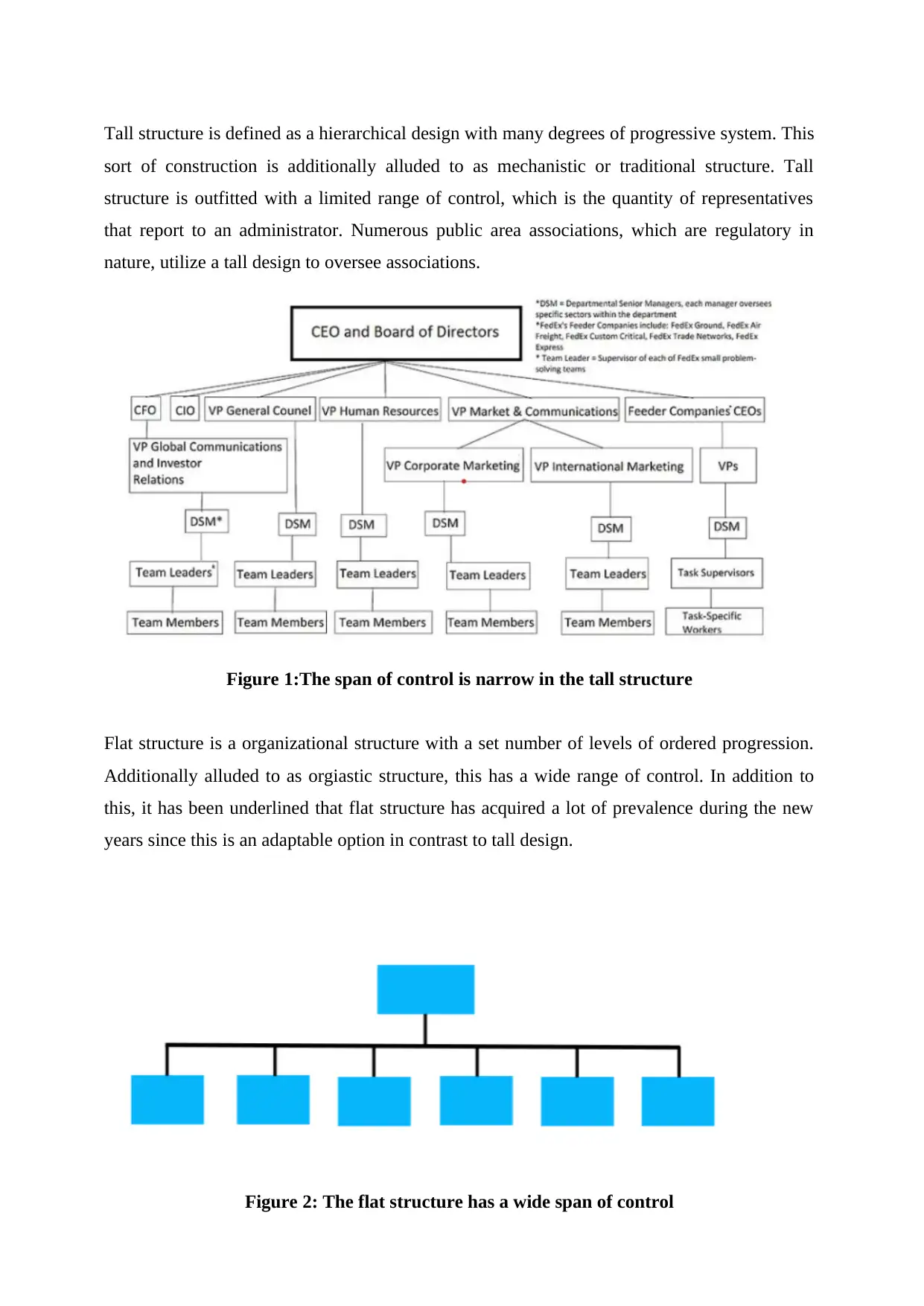
Tall structure is defined as a hierarchical design with many degrees of progressive system. This
sort of construction is additionally alluded to as mechanistic or traditional structure. Tall
structure is outfitted with a limited range of control, which is the quantity of representatives
that report to an administrator. Numerous public area associations, which are regulatory in
nature, utilize a tall design to oversee associations.
Figure 1:The span of control is narrow in the tall structure
Flat structure is a organizational structure with a set number of levels of ordered progression.
Additionally alluded to as orgiastic structure, this has a wide range of control. In addition to
this, it has been underlined that flat structure has acquired a lot of prevalence during the new
years since this is an adaptable option in contrast to tall design.
Figure 2: The flat structure has a wide span of control
sort of construction is additionally alluded to as mechanistic or traditional structure. Tall
structure is outfitted with a limited range of control, which is the quantity of representatives
that report to an administrator. Numerous public area associations, which are regulatory in
nature, utilize a tall design to oversee associations.
Figure 1:The span of control is narrow in the tall structure
Flat structure is a organizational structure with a set number of levels of ordered progression.
Additionally alluded to as orgiastic structure, this has a wide range of control. In addition to
this, it has been underlined that flat structure has acquired a lot of prevalence during the new
years since this is an adaptable option in contrast to tall design.
Figure 2: The flat structure has a wide span of control
Paraphrase This Document
Need a fresh take? Get an instant paraphrase of this document with our AI Paraphraser
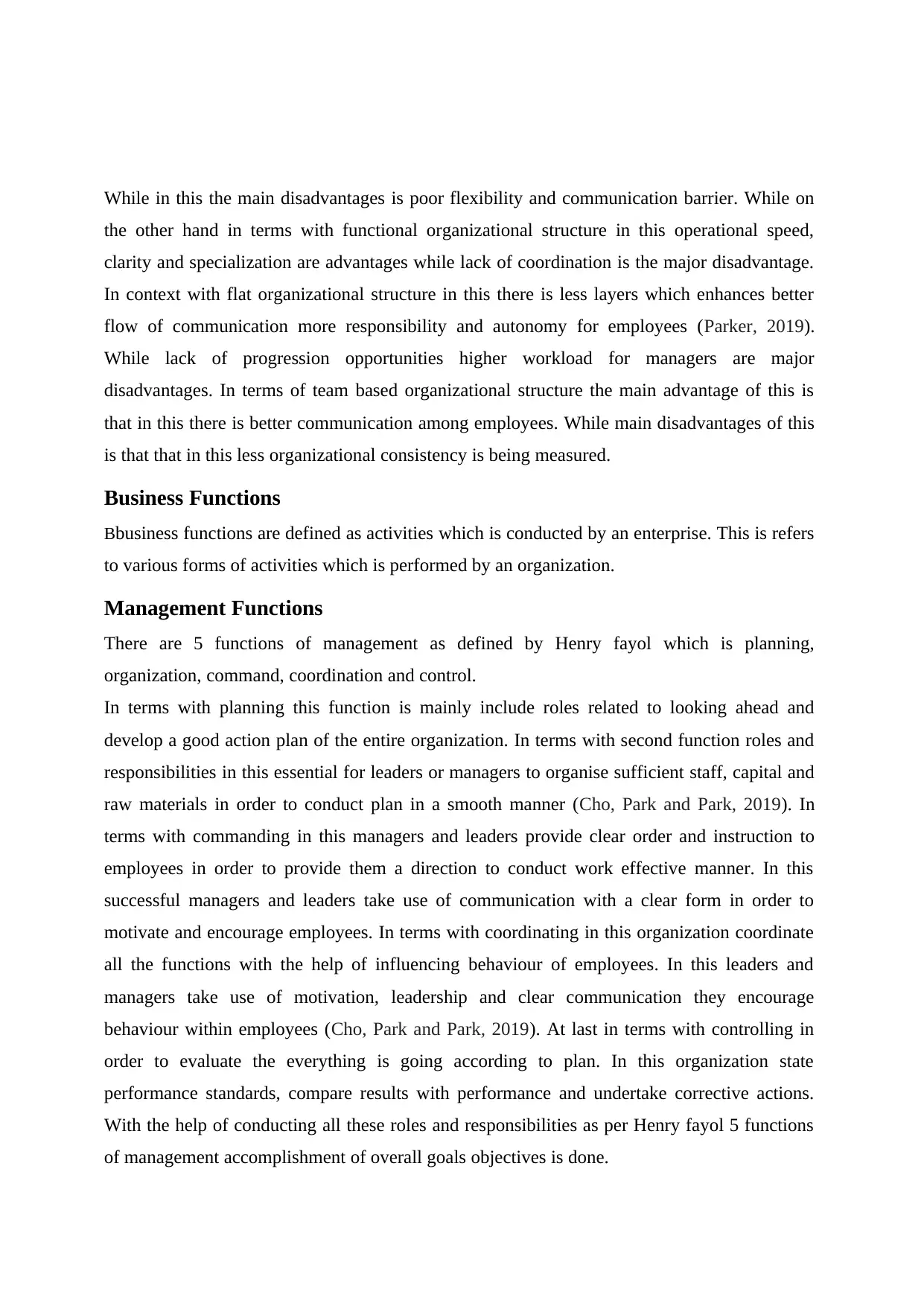
While in this the main disadvantages is poor flexibility and communication barrier. While on
the other hand in terms with functional organizational structure in this operational speed,
clarity and specialization are advantages while lack of coordination is the major disadvantage.
In context with flat organizational structure in this there is less layers which enhances better
flow of communication more responsibility and autonomy for employees (Parker, 2019).
While lack of progression opportunities higher workload for managers are major
disadvantages. In terms of team based organizational structure the main advantage of this is
that in this there is better communication among employees. While main disadvantages of this
is that that in this less organizational consistency is being measured.
Business Functions
Bbusiness functions are defined as activities which is conducted by an enterprise. This is refers
to various forms of activities which is performed by an organization.
Management Functions
There are 5 functions of management as defined by Henry fayol which is planning,
organization, command, coordination and control.
In terms with planning this function is mainly include roles related to looking ahead and
develop a good action plan of the entire organization. In terms with second function roles and
responsibilities in this essential for leaders or managers to organise sufficient staff, capital and
raw materials in order to conduct plan in a smooth manner (Cho, Park and Park, 2019). In
terms with commanding in this managers and leaders provide clear order and instruction to
employees in order to provide them a direction to conduct work effective manner. In this
successful managers and leaders take use of communication with a clear form in order to
motivate and encourage employees. In terms with coordinating in this organization coordinate
all the functions with the help of influencing behaviour of employees. In this leaders and
managers take use of motivation, leadership and clear communication they encourage
behaviour within employees (Cho, Park and Park, 2019). At last in terms with controlling in
order to evaluate the everything is going according to plan. In this organization state
performance standards, compare results with performance and undertake corrective actions.
With the help of conducting all these roles and responsibilities as per Henry fayol 5 functions
of management accomplishment of overall goals objectives is done.
the other hand in terms with functional organizational structure in this operational speed,
clarity and specialization are advantages while lack of coordination is the major disadvantage.
In context with flat organizational structure in this there is less layers which enhances better
flow of communication more responsibility and autonomy for employees (Parker, 2019).
While lack of progression opportunities higher workload for managers are major
disadvantages. In terms of team based organizational structure the main advantage of this is
that in this there is better communication among employees. While main disadvantages of this
is that that in this less organizational consistency is being measured.
Business Functions
Bbusiness functions are defined as activities which is conducted by an enterprise. This is refers
to various forms of activities which is performed by an organization.
Management Functions
There are 5 functions of management as defined by Henry fayol which is planning,
organization, command, coordination and control.
In terms with planning this function is mainly include roles related to looking ahead and
develop a good action plan of the entire organization. In terms with second function roles and
responsibilities in this essential for leaders or managers to organise sufficient staff, capital and
raw materials in order to conduct plan in a smooth manner (Cho, Park and Park, 2019). In
terms with commanding in this managers and leaders provide clear order and instruction to
employees in order to provide them a direction to conduct work effective manner. In this
successful managers and leaders take use of communication with a clear form in order to
motivate and encourage employees. In terms with coordinating in this organization coordinate
all the functions with the help of influencing behaviour of employees. In this leaders and
managers take use of motivation, leadership and clear communication they encourage
behaviour within employees (Cho, Park and Park, 2019). At last in terms with controlling in
order to evaluate the everything is going according to plan. In this organization state
performance standards, compare results with performance and undertake corrective actions.
With the help of conducting all these roles and responsibilities as per Henry fayol 5 functions
of management accomplishment of overall goals objectives is done.
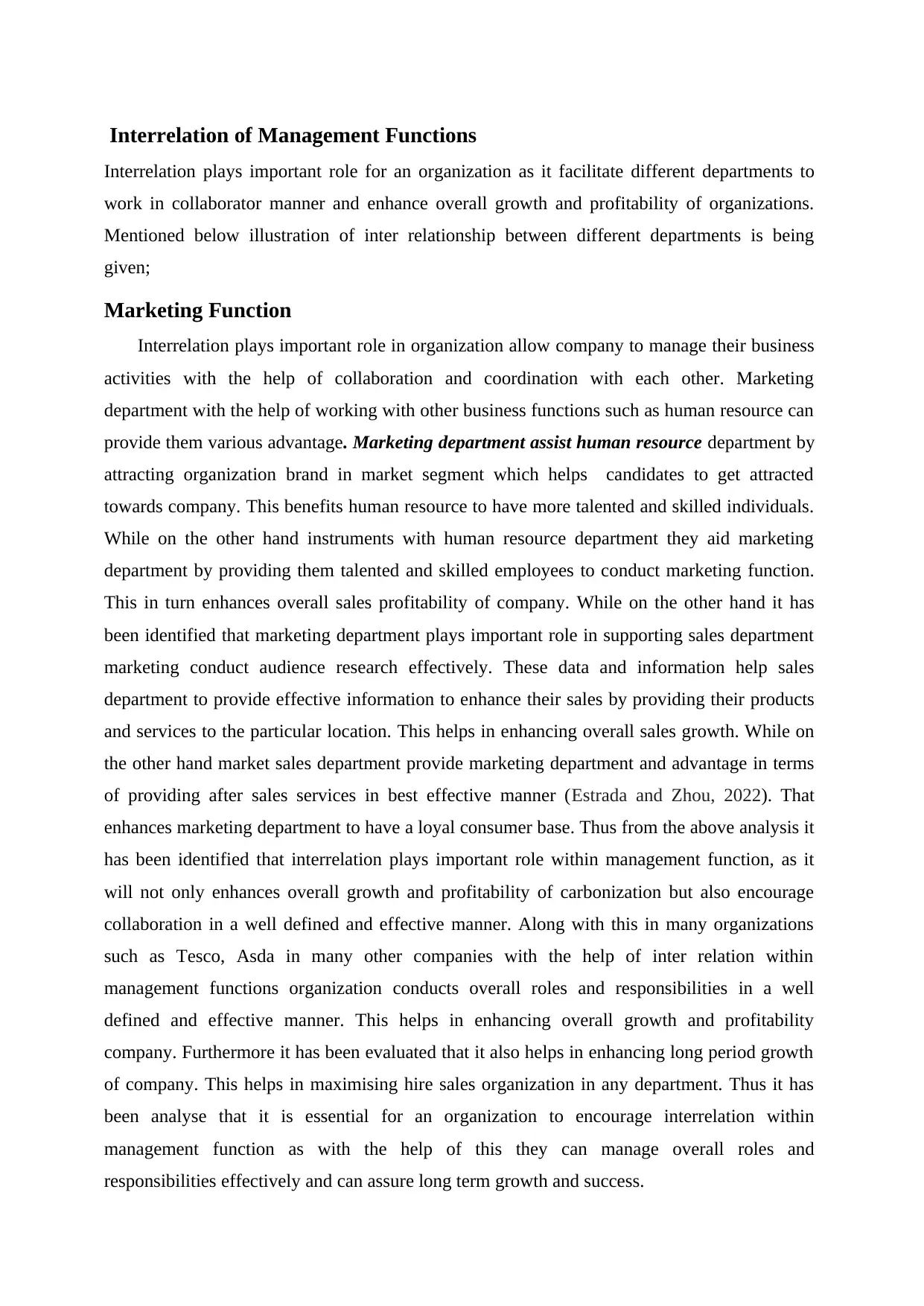
Interrelation of Management Functions
Interrelation plays important role for an organization as it facilitate different departments to
work in collaborator manner and enhance overall growth and profitability of organizations.
Mentioned below illustration of inter relationship between different departments is being
given;
Marketing Function
Interrelation plays important role in organization allow company to manage their business
activities with the help of collaboration and coordination with each other. Marketing
department with the help of working with other business functions such as human resource can
provide them various advantage. Marketing department assist human resource department by
attracting organization brand in market segment which helps candidates to get attracted
towards company. This benefits human resource to have more talented and skilled individuals.
While on the other hand instruments with human resource department they aid marketing
department by providing them talented and skilled employees to conduct marketing function.
This in turn enhances overall sales profitability of company. While on the other hand it has
been identified that marketing department plays important role in supporting sales department
marketing conduct audience research effectively. These data and information help sales
department to provide effective information to enhance their sales by providing their products
and services to the particular location. This helps in enhancing overall sales growth. While on
the other hand market sales department provide marketing department and advantage in terms
of providing after sales services in best effective manner (Estrada and Zhou, 2022). That
enhances marketing department to have a loyal consumer base. Thus from the above analysis it
has been identified that interrelation plays important role within management function, as it
will not only enhances overall growth and profitability of carbonization but also encourage
collaboration in a well defined and effective manner. Along with this in many organizations
such as Tesco, Asda in many other companies with the help of inter relation within
management functions organization conducts overall roles and responsibilities in a well
defined and effective manner. This helps in enhancing overall growth and profitability
company. Furthermore it has been evaluated that it also helps in enhancing long period growth
of company. This helps in maximising hire sales organization in any department. Thus it has
been analyse that it is essential for an organization to encourage interrelation within
management function as with the help of this they can manage overall roles and
responsibilities effectively and can assure long term growth and success.
Interrelation plays important role for an organization as it facilitate different departments to
work in collaborator manner and enhance overall growth and profitability of organizations.
Mentioned below illustration of inter relationship between different departments is being
given;
Marketing Function
Interrelation plays important role in organization allow company to manage their business
activities with the help of collaboration and coordination with each other. Marketing
department with the help of working with other business functions such as human resource can
provide them various advantage. Marketing department assist human resource department by
attracting organization brand in market segment which helps candidates to get attracted
towards company. This benefits human resource to have more talented and skilled individuals.
While on the other hand instruments with human resource department they aid marketing
department by providing them talented and skilled employees to conduct marketing function.
This in turn enhances overall sales profitability of company. While on the other hand it has
been identified that marketing department plays important role in supporting sales department
marketing conduct audience research effectively. These data and information help sales
department to provide effective information to enhance their sales by providing their products
and services to the particular location. This helps in enhancing overall sales growth. While on
the other hand market sales department provide marketing department and advantage in terms
of providing after sales services in best effective manner (Estrada and Zhou, 2022). That
enhances marketing department to have a loyal consumer base. Thus from the above analysis it
has been identified that interrelation plays important role within management function, as it
will not only enhances overall growth and profitability of carbonization but also encourage
collaboration in a well defined and effective manner. Along with this in many organizations
such as Tesco, Asda in many other companies with the help of inter relation within
management functions organization conducts overall roles and responsibilities in a well
defined and effective manner. This helps in enhancing overall growth and profitability
company. Furthermore it has been evaluated that it also helps in enhancing long period growth
of company. This helps in maximising hire sales organization in any department. Thus it has
been analyse that it is essential for an organization to encourage interrelation within
management function as with the help of this they can manage overall roles and
responsibilities effectively and can assure long term growth and success.
⊘ This is a preview!⊘
Do you want full access?
Subscribe today to unlock all pages.

Trusted by 1+ million students worldwide
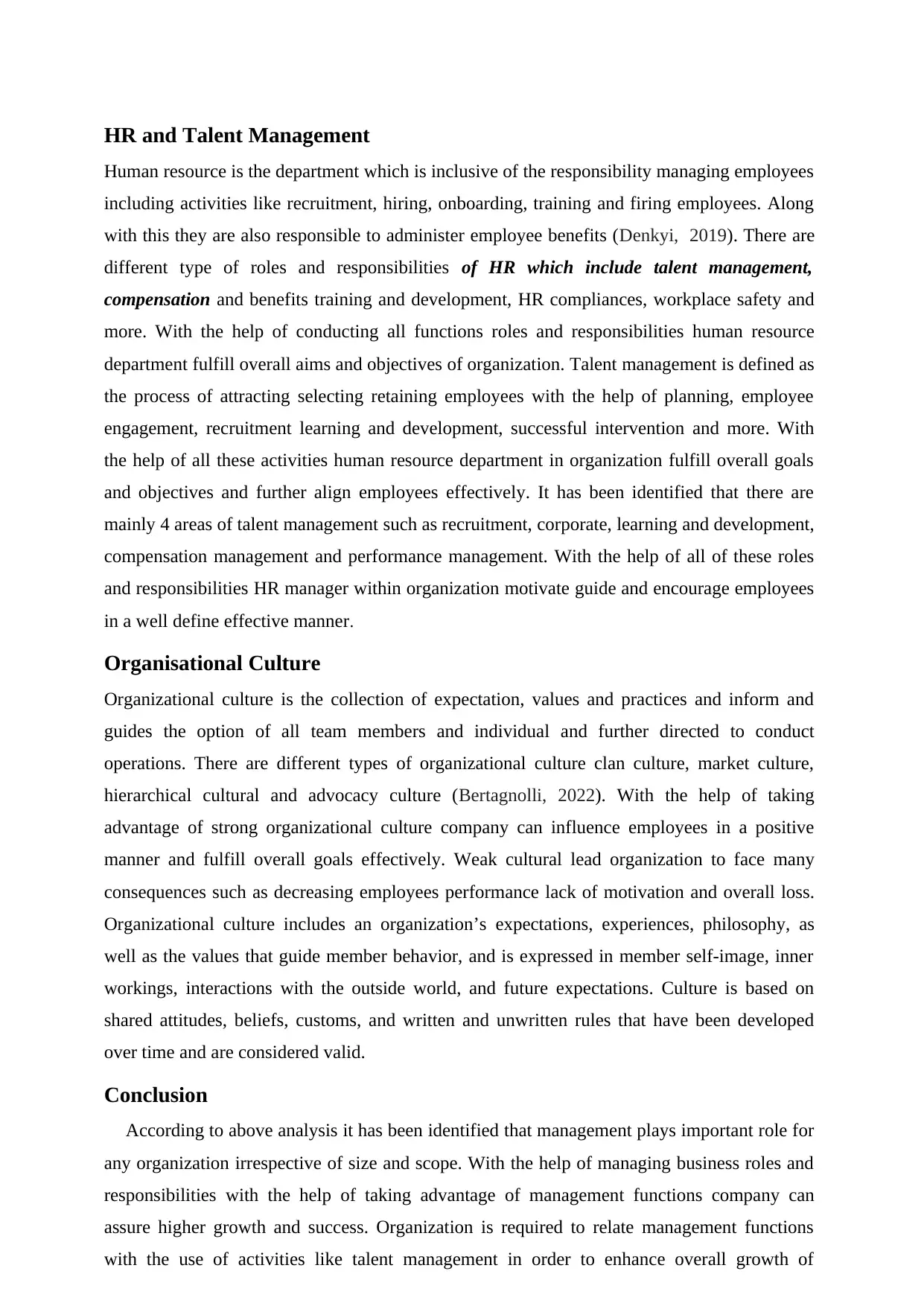
HR and Talent Management
Human resource is the department which is inclusive of the responsibility managing employees
including activities like recruitment, hiring, onboarding, training and firing employees. Along
with this they are also responsible to administer employee benefits (Denkyi, 2019). There are
different type of roles and responsibilities of HR which include talent management,
compensation and benefits training and development, HR compliances, workplace safety and
more. With the help of conducting all functions roles and responsibilities human resource
department fulfill overall aims and objectives of organization. Talent management is defined as
the process of attracting selecting retaining employees with the help of planning, employee
engagement, recruitment learning and development, successful intervention and more. With
the help of all these activities human resource department in organization fulfill overall goals
and objectives and further align employees effectively. It has been identified that there are
mainly 4 areas of talent management such as recruitment, corporate, learning and development,
compensation management and performance management. With the help of all of these roles
and responsibilities HR manager within organization motivate guide and encourage employees
in a well define effective manner.
Organisational Culture
Organizational culture is the collection of expectation, values and practices and inform and
guides the option of all team members and individual and further directed to conduct
operations. There are different types of organizational culture clan culture, market culture,
hierarchical cultural and advocacy culture (Bertagnolli, 2022). With the help of taking
advantage of strong organizational culture company can influence employees in a positive
manner and fulfill overall goals effectively. Weak cultural lead organization to face many
consequences such as decreasing employees performance lack of motivation and overall loss.
Organizational culture includes an organization’s expectations, experiences, philosophy, as
well as the values that guide member behavior, and is expressed in member self-image, inner
workings, interactions with the outside world, and future expectations. Culture is based on
shared attitudes, beliefs, customs, and written and unwritten rules that have been developed
over time and are considered valid.
Conclusion
According to above analysis it has been identified that management plays important role for
any organization irrespective of size and scope. With the help of managing business roles and
responsibilities with the help of taking advantage of management functions company can
assure higher growth and success. Organization is required to relate management functions
with the use of activities like talent management in order to enhance overall growth of
Human resource is the department which is inclusive of the responsibility managing employees
including activities like recruitment, hiring, onboarding, training and firing employees. Along
with this they are also responsible to administer employee benefits (Denkyi, 2019). There are
different type of roles and responsibilities of HR which include talent management,
compensation and benefits training and development, HR compliances, workplace safety and
more. With the help of conducting all functions roles and responsibilities human resource
department fulfill overall aims and objectives of organization. Talent management is defined as
the process of attracting selecting retaining employees with the help of planning, employee
engagement, recruitment learning and development, successful intervention and more. With
the help of all these activities human resource department in organization fulfill overall goals
and objectives and further align employees effectively. It has been identified that there are
mainly 4 areas of talent management such as recruitment, corporate, learning and development,
compensation management and performance management. With the help of all of these roles
and responsibilities HR manager within organization motivate guide and encourage employees
in a well define effective manner.
Organisational Culture
Organizational culture is the collection of expectation, values and practices and inform and
guides the option of all team members and individual and further directed to conduct
operations. There are different types of organizational culture clan culture, market culture,
hierarchical cultural and advocacy culture (Bertagnolli, 2022). With the help of taking
advantage of strong organizational culture company can influence employees in a positive
manner and fulfill overall goals effectively. Weak cultural lead organization to face many
consequences such as decreasing employees performance lack of motivation and overall loss.
Organizational culture includes an organization’s expectations, experiences, philosophy, as
well as the values that guide member behavior, and is expressed in member self-image, inner
workings, interactions with the outside world, and future expectations. Culture is based on
shared attitudes, beliefs, customs, and written and unwritten rules that have been developed
over time and are considered valid.
Conclusion
According to above analysis it has been identified that management plays important role for
any organization irrespective of size and scope. With the help of managing business roles and
responsibilities with the help of taking advantage of management functions company can
assure higher growth and success. Organization is required to relate management functions
with the use of activities like talent management in order to enhance overall growth of
Paraphrase This Document
Need a fresh take? Get an instant paraphrase of this document with our AI Paraphraser

employees. With the help of strong organizational culture company can provide employees of
workplace environment in which they are motivated and perform their responsibilities in more
effective manner.
workplace environment in which they are motivated and perform their responsibilities in more
effective manner.
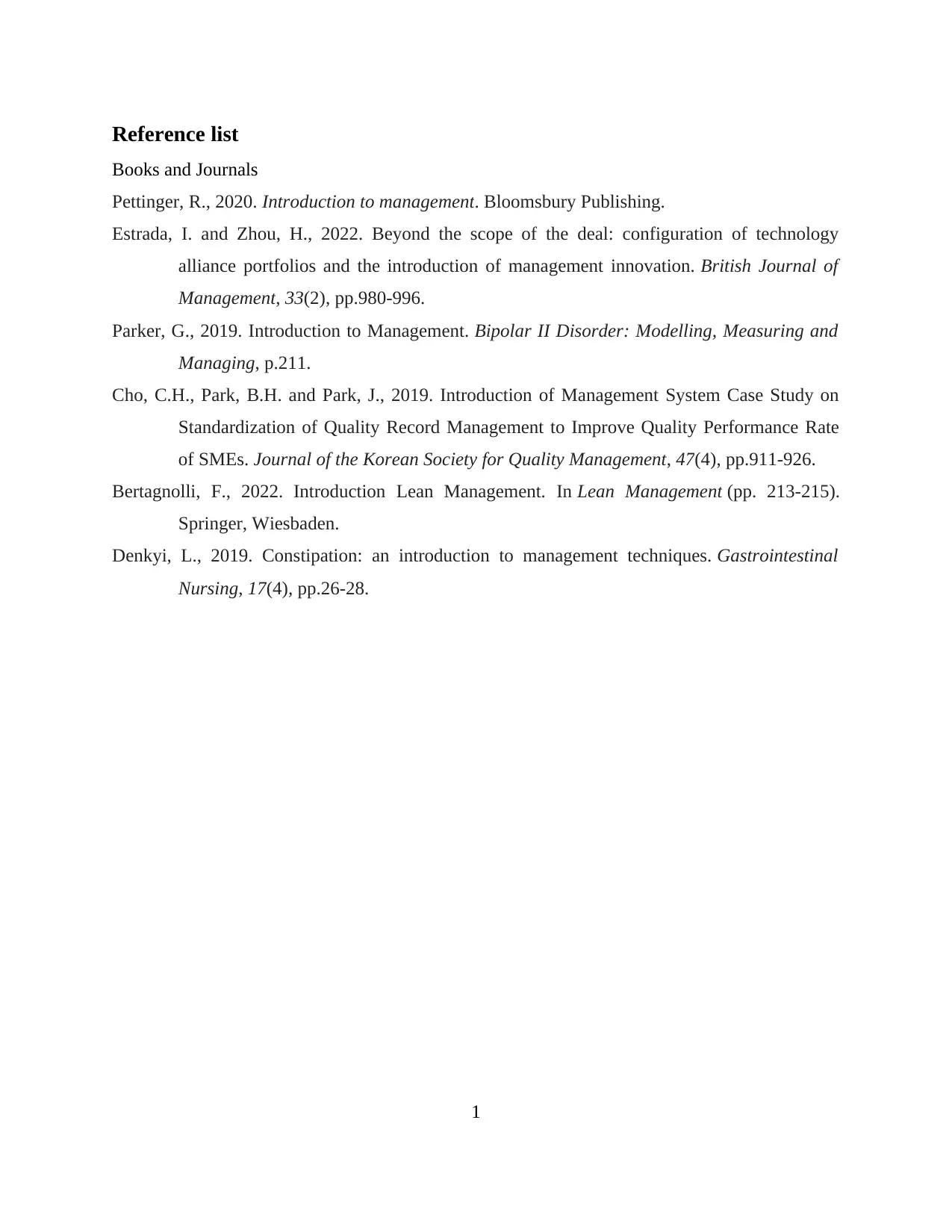
Reference list
Books and Journals
Pettinger, R., 2020. Introduction to management. Bloomsbury Publishing.
Estrada, I. and Zhou, H., 2022. Beyond the scope of the deal: configuration of technology
alliance portfolios and the introduction of management innovation. British Journal of
Management, 33(2), pp.980-996.
Parker, G., 2019. Introduction to Management. Bipolar II Disorder: Modelling, Measuring and
Managing, p.211.
Cho, C.H., Park, B.H. and Park, J., 2019. Introduction of Management System Case Study on
Standardization of Quality Record Management to Improve Quality Performance Rate
of SMEs. Journal of the Korean Society for Quality Management, 47(4), pp.911-926.
Bertagnolli, F., 2022. Introduction Lean Management. In Lean Management (pp. 213-215).
Springer, Wiesbaden.
Denkyi, L., 2019. Constipation: an introduction to management techniques. Gastrointestinal
Nursing, 17(4), pp.26-28.
1
Books and Journals
Pettinger, R., 2020. Introduction to management. Bloomsbury Publishing.
Estrada, I. and Zhou, H., 2022. Beyond the scope of the deal: configuration of technology
alliance portfolios and the introduction of management innovation. British Journal of
Management, 33(2), pp.980-996.
Parker, G., 2019. Introduction to Management. Bipolar II Disorder: Modelling, Measuring and
Managing, p.211.
Cho, C.H., Park, B.H. and Park, J., 2019. Introduction of Management System Case Study on
Standardization of Quality Record Management to Improve Quality Performance Rate
of SMEs. Journal of the Korean Society for Quality Management, 47(4), pp.911-926.
Bertagnolli, F., 2022. Introduction Lean Management. In Lean Management (pp. 213-215).
Springer, Wiesbaden.
Denkyi, L., 2019. Constipation: an introduction to management techniques. Gastrointestinal
Nursing, 17(4), pp.26-28.
1
⊘ This is a preview!⊘
Do you want full access?
Subscribe today to unlock all pages.

Trusted by 1+ million students worldwide
1 out of 9
Related Documents
Your All-in-One AI-Powered Toolkit for Academic Success.
+13062052269
info@desklib.com
Available 24*7 on WhatsApp / Email
![[object Object]](/_next/static/media/star-bottom.7253800d.svg)
Unlock your academic potential
Copyright © 2020–2025 A2Z Services. All Rights Reserved. Developed and managed by ZUCOL.




